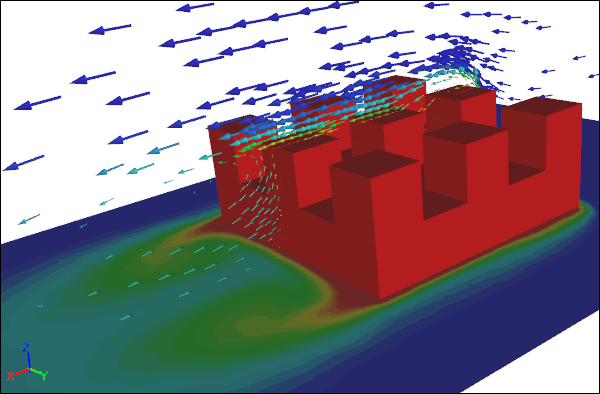
Enhanced CFD Simulations with Conjugate Heat Transfer and Passive Species Transport
The highlight of the latest Caedium (v6.0) release is an enhanced Computational Fluid Dynamics (CFD) heat transfer capability with multi-domain support for fluids and solids, known as Conjugate Heat Transfer (CHT). Also Caedium can now simulate the dispersal of secondary species (e.g., smoke or dye) in a primary fluid, known as passive species (or scalar) transport.
 Conjugate Heat Transfer (CHT) Through and Around a Heat Sink
Conjugate Heat Transfer (CHT) Through and Around a Heat Sink
Simulation shows air vectors and floor colored by temperature
Request and activate a free 30-day trial to enable Computational Fluid Dynamics (CFD) software simulation in Caedium. ![]()
Conjugate Heat Transfer
CHT models the heat transfer through a solid or shell, coupled with a fluid at shared boundaries. Applications include:
- Electronics cooling, e.g., chip cooling with heat sinks
- Heat exchangers in various industries, e.g., automotive, aerospace, power generation, oil and gas processing
CHT simplifies the specification of heat transfer between a wall and a fluid. Instead of having to define a heat flux on a fluid wall you can now just specify the heat flux on the external wall of a solid (e.g., heat sink) or another fluid (e.g., water-air heat exchanger). Then CHT automatically simulates the heat transfer through the heat source and into the coupled fluid.
 Water-Air Heat Exchanger
Water-Air Heat Exchanger
Simulation shows water vectors colored by temperature
Passive Species Transport
A passive species can represent and track additions such as smoke in airflow and dye in water. It can also provide insights on the dispersion of pollutants carried by a fluid. Since it is passive, the species has identical physical properties to the primary simulation substance and does not react with it. A passive species is similar to massless particles (streamlines) except instead of being released at discrete points, the passive species behaves as a continuous field like temperature.
 Passive Species Released in a Helix-Fluted Chimney
Passive Species Released in a Helix-Fluted Chimney
Simulation shows a clipped image of iso-surfaces for a released species
Subsystem Update
Realize faster and more robust operations with major updates to all the Caedium subsystems: Open Cascade, OpenFOAM®, VTK, and wxWidgets.
OpenFOAM is a registered trademark of OpenCFD and is unaffiliated with Symscape.
